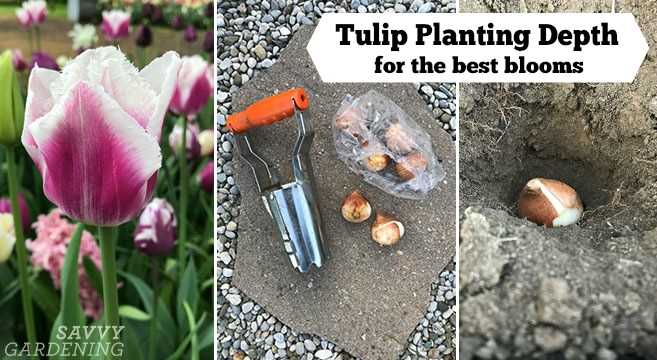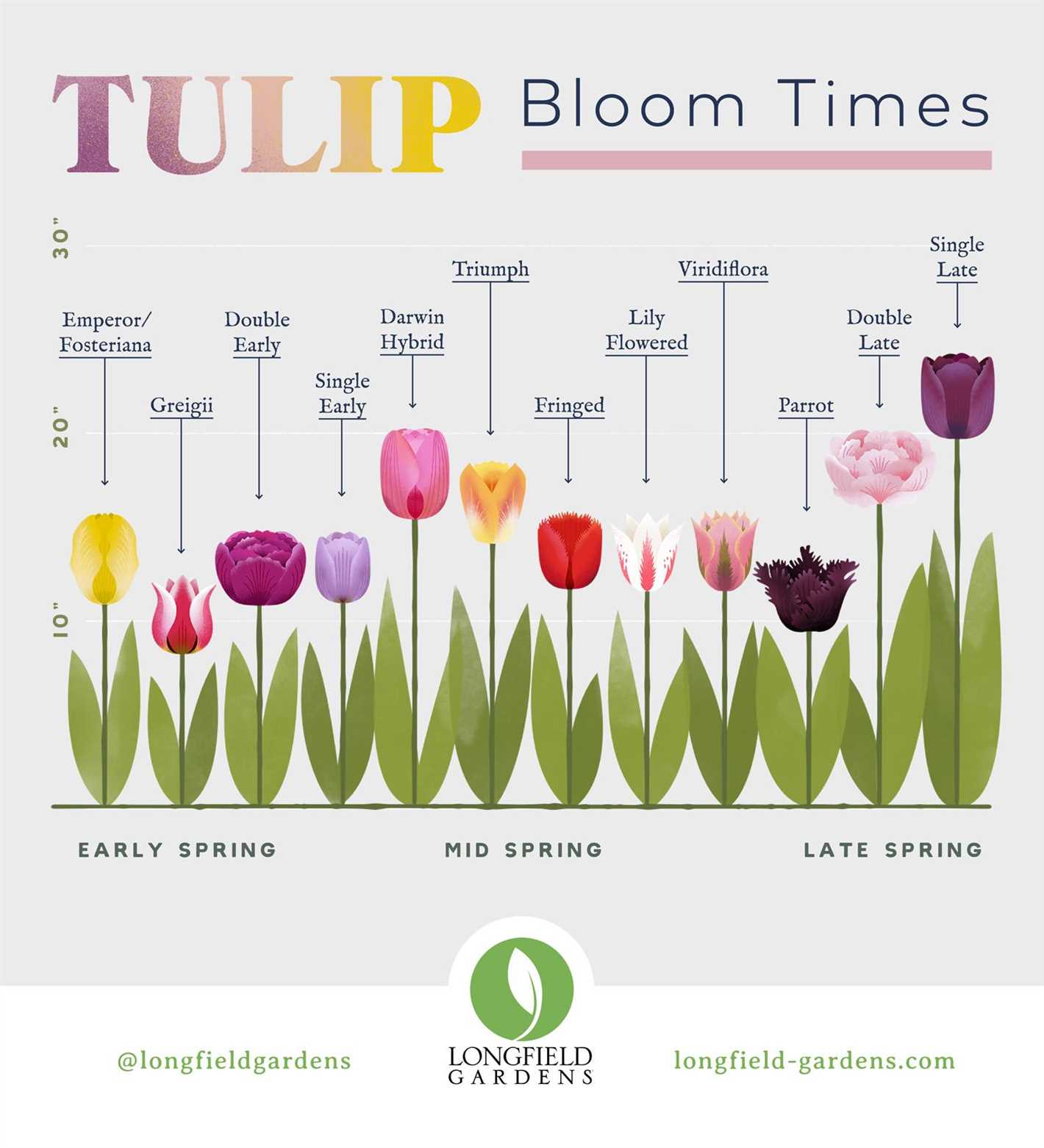- The Best Time to Plant Tulip Bulbs in Autumn
- When to Plant Tulip Bulbs for Stunning Spring Blooms
- The Importance of Timing for Successful Tulip Planting
- Planting Depth Guide for Tulip Bulbs
- General Guidelines
- Exception for Species Tulips
- Planting Depth Tips
- How Deep Should Tulip Bulbs be Planted?
- Factors to Consider when Determining Planting Depth
- Tips and Tricks for Successful Autumn Planting of Tulips
- Preparing the Soil for Tulip Bulbs in Autumn
- 1. Choose the Right Location
- 2. Clear the Area
- 3. Improve Drainage
- 4. Test the Soil
- 5. Add Fertilizer
- 6. Prepare the Planting Bed
- 7. Planting Depth
- 8. Spacing
- Questions and Answers:
- When is the best time to plant tulips in autumn?
- Can I plant tulips in November?
- How deep should I plant tulip bulbs?
- What is the planting depth for tulip bulbs in heavy clay soil?
- How long does it take for tulip bulbs to sprout after planting in autumn?
- Can I plant tulips in spring instead of autumn?
- Videos: Growing Tulips in the Fall – How to Plant Tulip Bulbs | Kelly Lehman
Autumn is the perfect time to plant tulips, as the cooler temperatures and moist soil create the ideal conditions for their growth. When it comes to planting tulips, timing is crucial. The general rule of thumb is to plant tulip bulbs in the fall, preferably between late September and early November.
To ensure successful growth, it is important to plant tulips at the appropriate depth. The planting depth depends on the size and type of tulip bulbs. As a general guideline, larger bulbs should be planted deeper, while smaller bulbs should be planted more shallowly. The recommended planting depth is usually about two to three times the height of the bulb.
When planting tulips, it is also important to choose a location that receives full sunlight. Tulips thrive in well-drained soil, so make sure to avoid planting them in areas that are prone to waterlogging. Additionally, it is a good idea to add organic matter to the soil before planting to improve its fertility and drainage.
Once the bulbs are planted, it is essential to water them thoroughly. This will help settle the soil and ensure that the bulbs are in contact with it. After planting, it is important to cover the area with a layer of mulch to protect the bulbs from extreme temperatures and to retain moisture in the soil.
The Best Time to Plant Tulip Bulbs in Autumn
Planting tulip bulbs in autumn is an essential step to ensure a colorful spring garden. While there is some flexibility in the timing, it is generally recommended to plant tulip bulbs in autumn when the soil temperature has cooled down.
Timing:
Tulip bulbs should be planted in autumn, ideally between September and November, before the first frost sets in. Planting at this time allows the bulbs to establish their roots before the ground freezes over for winter.
Soil Temperature:
The ideal soil temperature for planting tulip bulbs is around 50 to 60 degrees Fahrenheit (10 to 15 degrees Celsius). This temperature range ensures that the bulbs can start developing their root system without being exposed to excessively cold or warm soil conditions.
Preparing the Soil:
Before planting tulip bulbs, it is crucial to prepare the soil properly. The soil should be well-drained and fertile to promote healthy bulb growth. Remove any weeds or roots from the planting area and amend the soil with compost or well-rotted manure to improve its fertility.
Planting Depth:
Tulip bulbs should be planted at a depth of approximately 6 to 8 inches (15 to 20 centimeters). This depth provides sufficient insulation and protection for the bulbs during winter while allowing them to emerge easily in spring.
Planting Guide:
- Choose a location in your garden that receives full sun or partial shade.
- Dig a hole with a trowel or garden fork that is deep enough to accommodate the bulbs at the recommended planting depth.
- Place the bulbs in the hole with their pointed ends facing upwards.
- Cover the bulbs with soil, firming it gently to eliminate air pockets.
- Water the planting area thoroughly to help settle the soil and initiate root growth.
Conclusion:
Planting tulip bulbs in autumn is a rewarding endeavor that ensures a beautiful display of vibrant blooms in spring. By timing the planting correctly, preparing the soil adequately, and planting the bulbs at the proper depth, you can set the stage for a stunning tulip show in your garden.
When to Plant Tulip Bulbs for Stunning Spring Blooms

Tulips are one of the most beautiful flowers that bloom in the spring. Their vibrant colors and elegant shapes can add a touch of elegance to any garden. To ensure that you have a stunning display of tulips in the spring, it is important to plant the bulbs at the right time.
Timing: It is recommended to plant tulip bulbs in the autumn, around September to October. This allows the bulbs to establish their root systems before the frost sets in. Planting in the autumn also gives the bulbs a cold period, which is essential for their growth and flowering in the spring.
Planting Depth: The depth at which tulip bulbs should be planted depends on their size. As a general guide, larger bulbs should be planted deeper than smaller bulbs. A rule of thumb is to plant tulip bulbs at a depth that is three times the height of the bulb. For example, if a bulb is 2 inches tall, it should be planted 6 inches deep.
Preparing the Soil: Before planting tulip bulbs, it is important to prepare the soil properly. Tulips prefer well-draining soil that is rich in organic matter. You can add compost or well-rotted manure to improve the soil’s fertility and drainage.
Planting Technique: To plant tulip bulbs, dig a hole that is deep enough to accommodate the bulb and provide adequate space for the roots to grow. Place the bulb in the hole with the pointed end facing upwards. Gently cover the bulb with soil and firm it down to eliminate any air pockets.
Care and Maintenance: After planting the tulip bulbs, water them thoroughly to help settle the soil and encourage root growth. In regions with harsh winters, you can cover the planting area with a layer of mulch to protect the bulbs from freezing temperatures. It is also important to remove any weeds or competing plants from the area to avoid competition for nutrients and water.
Final Words: By planting tulip bulbs in the autumn and providing them with the right conditions, you can expect stunning spring blooms that will brighten up your garden. Remember to choose healthy bulbs, plant them at the right depth, and provide them with proper care and maintenance throughout the growing season.
The Importance of Timing for Successful Tulip Planting
Timing plays a crucial role in the success of planting tulips in the autumn. Planting tulip bulbs at the right time allows them to establish their roots before the ground freezes, ensuring healthy growth and flowering in the spring.
Early Planting:
Planting tulip bulbs too early in the autumn can result in premature sprouting, which may be damaged by sudden frost or cold temperatures. To avoid this, it is recommended to wait until the soil temperature drops to around 60°F (15°C) before planting.
Late Planting:
On the other hand, planting tulip bulbs too late in the autumn may not allow them enough time to develop strong roots before the ground freezes. This can lead to weak or stunted growth in the spring. It is recommended to plant tulip bulbs at least 4-6 weeks before the first hard frost in your area.
Choosing the Right Time:
It is important to consider the specific climate and weather conditions of your region when determining the best time for tulip planting. Pay attention to local frost dates and average soil temperatures to make an informed decision.
Planting Depth:
Another aspect of timing to consider is the planting depth of tulip bulbs. Planting too shallow or too deep can affect their ability to establish roots and grow properly. As a general guideline, tulip bulbs should be planted at a depth of approximately 6-8 inches (15-20 cm).
Summary:
- Plant tulip bulbs when the soil temperature drops to around 60°F (15°C)
- Avoid planting tulip bulbs too early or too late in the autumn
- Consider local frost dates and average soil temperatures
- Plant tulip bulbs at a depth of 6-8 inches (15-20 cm)
By taking into account the timing and planting depth, you can ensure the successful growth and flowering of your tulips in the following spring.
Planting Depth Guide for Tulip Bulbs
Planting depth is an important factor to consider when planting tulip bulbs in the autumn. The depth at which you plant your bulbs will affect their overall growth and blooming potential. Here is a guide to help you determine the ideal planting depth for your tulip bulbs:
General Guidelines
- For most tulip varieties, the general rule of thumb is to plant the bulbs at a depth that is approximately 2-3 times the height of the bulb. This means that if your tulip bulb is 2 inches tall, you should aim to plant it at a depth of 4-6 inches.
- If you are unsure about the specific variety of tulip you are planting, it is best to err on the side of planting the bulbs slightly deeper rather than too shallow. Tulips are generally forgiving when it comes to planting depth, but planting them too shallowly can result in weaker growth and reduced blooming.
Exception for Species Tulips
Species tulips, also known as wild tulips, have slightly different requirements when it comes to planting depth. These tulips tend to be smaller in size and therefore should be planted at a shallower depth compared to hybrid varieties.
- For species tulips, aim to plant the bulbs at a depth that is approximately 1.5-2 times the height of the bulb. This means that if your species tulip bulb is 1 inch tall, you should plant it at a depth of 1.5-2 inches.
Planting Depth Tips

Here are some additional tips to keep in mind when determining the planting depth of your tulip bulbs:
- Measure the height of your tulip bulb from the base to the tip to ensure accurate planting depth.
- If planting your tulips in containers, consider planting them slightly deeper to protect them from colder temperatures.
- Use a ruler or a planting depth tool to help you achieve the desired depth when planting your bulbs.
- It is important to note that planting depth recommendations may vary slightly depending on the specific variety of tulip and the climate in which you are planting. It is always best to consult the specific planting guidelines provided by the bulb supplier.
By following these guidelines for planting depth, you can ensure that your tulip bulbs have the best chance of thriving and producing beautiful blooms in the spring.
How Deep Should Tulip Bulbs be Planted?

- Tulip bulbs should be planted at a depth of 6 to 8 inches (15 to 20 cm).
- You want to ensure that the bulbs are deep enough to protect them from frost and extreme temperature fluctuations.
- To achieve the correct planting depth, use a garden trowel or bulb planter to dig a hole that is roughly 3 times the height of the bulb.
- If you are planting multiple tulip bulbs, space them about 4 to 6 inches (10 to 15 cm) apart to allow for proper root growth.
- When placing the bulbs in the hole, make sure that the pointed end of the bulb is facing upwards. This is the end from which the stem and flowers will emerge.
- After placing the bulb in the hole, cover it with soil and gently firm the soil around it to remove any air pockets.
- Water the area thoroughly after planting to help settle the soil.
Proper planting depth is important for the successful growth and bloom of tulips. Planting bulbs too shallow may leave them vulnerable to damage from frost or drying out, while planting them too deep may inhibit their ability to sprout and flower. By following the recommended planting depth and spacing, you can ensure that your tulips will thrive and bring beauty to your garden in the spring.
Factors to Consider when Determining Planting Depth
Determining the appropriate planting depth for tulip bulbs is crucial for their successful growth and blooming. Several factors should be taken into consideration when determining the planting depth:
- The size of the tulip bulb: Larger bulbs are typically planted deeper than smaller ones. This helps to ensure that the bulb has enough soil cover for proper insulation and protection.
- The soil type: The type of soil in your garden can also influence the planting depth. Heavy clay soils retain more moisture, so bulbs planted too deep may become waterlogged. Sandy soils, on the other hand, drain quickly and may require deeper planting to provide enough moisture retention.
- Garden location: The location of your garden can impact the planting depth as well. If your garden is in a windy or exposed area, deeper planting can help anchor the tulip bulbs and prevent them from being lifted out of the ground.
- Climate: The climate in your region should be considered when determining the planting depth. In colder regions, planting bulbs deeper can help protect them from frost. In milder climates, shallower planting depths may be sufficient.
- Variety of tulip: Different tulip varieties have specific planting depth requirements. It is important to research the specific requirements for each variety you plan to grow.
Overall, the ideal planting depth for tulip bulbs is typically around 6-8 inches (15-20 cm). However, these factors should be taken into account to determine the best planting depth for your specific situation. Taking the time to properly consider these factors will help ensure the healthy growth and blooming of your tulips.
Tips and Tricks for Successful Autumn Planting of Tulips
- Choose the right time: Autumn is the ideal time to plant tulip bulbs. Aim for a planting date about 6 weeks before the ground freezes to give the bulbs time to establish roots.
- Prepare the soil: Tulips prefer well-drained soil, so it’s important to amend heavy or clay soils with organic matter like compost or peat moss. This will help improve the drainage and fertility of the soil.
- Select the right location: Tulips thrive in full sun to partial shade. Choose a spot in your garden that receives at least 6 hours of direct sunlight each day. Avoid areas with excessive moisture, as this can rot the bulbs.
- Plant at the right depth: Tulip bulbs should be planted at a depth of 6 to 8 inches. Use a trowel or bulb planter to dig a hole and place the bulb with the pointed end facing up. Cover the bulb with soil and gently firm it in place.
- Spacing is key: Plant tulip bulbs about 4 to 6 inches apart to allow for proper air circulation and avoid overcrowding. This will help prevent diseases and promote healthy growth.
- Protect from pests: Tulips can be a tasty treat for rodents like mice and voles. To protect your bulbs, consider placing wire mesh or using bulb cages when planting. You can also use natural deterrents like garlic or pepper.
- Water and mulch: After planting, water the bulbs thoroughly to settle the soil and encourage root growth. Apply a layer of mulch, such as straw or shredded leaves, to help conserve moisture and regulate soil temperature.
- Keep an eye on blooms: Once your tulips start to bloom in the spring, remove any spent flowers to prevent the bulbs from expending energy on seed production. This will help ensure the bulbs store up energy for next year’s growth.
- Consider companion planting: Tulips can benefit from being planted alongside other spring-blooming bulbs or perennials. Consider pairing them with daffodils, hyacinths, or other flowers that bloom around the same time for a stunning display.
By following these tips and tricks, you can enjoy a beautiful display of tulips in your garden next spring. With proper planting and care, your tulips will reward you with vibrant colors and elegant blooms.
Preparing the Soil for Tulip Bulbs in Autumn
Preparing the soil is a crucial step in ensuring the successful growth of tulip bulbs during autumn planting. The right soil conditions provide a healthy environment for the bulbs to establish and thrive.
1. Choose the Right Location
Select a location that receives full sun or at least 6 hours of direct sunlight per day. Tulips prefer well-draining soil, so avoid areas that are prone to waterlogging or areas with heavy clay soil.
2. Clear the Area
Remove any existing plants, weeds, or debris from the planting area. Tulips perform best when they have access to all the nutrients in the soil without competition from other plants.
3. Improve Drainage
If the soil in your chosen location is heavy or poorly draining, you may need to improve the drainage. You can amend the soil with organic matter, such as compost or well-rotted manure, to help break up the soil and improve its drainage capabilities.
4. Test the Soil

It’s a good idea to test the pH and nutrient levels of the soil before planting tulip bulbs. You can use a home soil testing kit or send a soil sample to a local agricultural extension office for analysis. This information will help you determine if any additional amendments are needed.
5. Add Fertilizer
Based on the soil test results, you may need to add fertilizer to provide the necessary nutrients for the tulip bulbs. A slow-release, balanced fertilizer with a ratio of 10-10-10 or similar can be applied according to the package instructions.
6. Prepare the Planting Bed
Loosen the soil in the planting bed to a depth of about 8-10 inches using a garden fork or tiller. Break up any large clumps and remove any rocks or debris. This will create a loose, well-aerated soil that allows the tulip bulbs to establish their roots more easily.
7. Planting Depth
Follow the recommended planting depth for the specific variety of tulip bulbs you have purchased. Generally, tulip bulbs are planted at a depth of approximately 6-8 inches. Use a measuring tape or ruler to ensure consistency.
8. Spacing
Space the tulip bulbs according to the guidelines provided on the packaging or at least 4-6 inches apart to allow for adequate airflow and growth.
By following these steps, you can ensure that your soil is properly prepared for your autumn planting of tulip bulbs. With the right conditions, your tulips will bloom beautifully in the spring.
Questions and Answers:
When is the best time to plant tulips in autumn?
The best time to plant tulips in autumn is usually between September and October.
Can I plant tulips in November?
While it is possible to plant tulips in November, it is generally recommended to plant them earlier in the autumn to give them enough time to establish their roots before the ground freezes.
How deep should I plant tulip bulbs?
Tulip bulbs should be planted at a depth of about 6 to 8 inches (15 to 20 centimeters).
What is the planting depth for tulip bulbs in heavy clay soil?
In heavy clay soil, tulip bulbs should be planted at a depth of about 8 to 10 inches (20 to 25 centimeters).
How long does it take for tulip bulbs to sprout after planting in autumn?
After planting in autumn, tulip bulbs usually take about 2 to 3 weeks to sprout, depending on the variety and weather conditions.
Can I plant tulips in spring instead of autumn?
Tulips are traditionally planted in autumn for best results, as they require a period of cold dormancy to bloom. However, if you missed the autumn planting window, you can try planting tulips in spring, although they may not flower as well.







